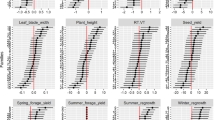Abstract
Alfalfa cultivar development will be enhanced by breeding strategies whichutilize the full potential of autotetraploid population genetic structures. Thisstudy evaluates the effectiveness of an allelic selection scheme, which wasdeveloped to overcome limitations of inbreeding depression and to exploitgeneral and specific combining ability effects in autotetraploid populations.Allelic selection entails the minimization of non-additive genetic effects byselecting among full-sib families (F1) which are at uniform levels ofheterozygosity. Such F1 lines are developed by crossing individuals fromtwo unrelated random mating populations. Selected F1 lines wereintercrossed to form an improved population. Eight random matingpopulations of alfalfa were developed to study the effectiveness of allelicselection. Selection for increased dry matter yield resulted in alfalfapopulations with 38 percent greater yield than the parent populations. Twocycles of intercrossing, among selected F1 lines, did not dissipate the gainfrom selection. This result has important implications for synthetic cultivardevelopment in which a major limitation is the decline in productivity withadvancing generations of seed increase. A positively correlated response toselection for dry matter yield was observed for plant height and stemdiameter. The results of this research indicate that continued testing of theallelic selection scheme is warranted and could have a significant impact onthe breeding of autotetraploid alfalfa, particularly for synthetic cultivardevelopment.
Similar content being viewed by others
References
Bingham, E.T., 1980. Maximizing heterozygosity in autopolyploids. In: Lewis (Ed.), Polyploidy: Biological Relevance, pp. 471–491. Plenum Press, New York.
Bingham, E.T., 1983. Maximizing hybrid vigor in tetraploid alfalfa. In: Nugent & O'Conor (Eds.), Better Crops for Food, pp. 130–143. CIBA Foundation, London.
Bingham, E.T., R.W. Groose, D.R. Woodfield & K.K. Kidwell, 1994. Complementary gene interactions in alfalfa are greater in autotetraploids than diploids. Crop Sci 34: 823–829.
Bonierbale, M.W., R.L. Plaisted & S.D. Tanksley, 1993. A test of the maximum heterozygosity hypothesis using molecular markers in tetraploid potatoes. Theor Appl Genet 86: 481–491.
Bowley, S.R. & B.R. Christie, 1981. Inheritance of dry matter yield in a heterozygous population of alfalfa. Can J Plant Sci 61: 313–318.
Busbice, T.H. & C.P. Wilsie, 1966. Inbreeding depression and heterosis in autotetraploids with application to Medicago sativa L. Euphytica 15: 52–67.
Carnahan, H.L., 1960. Some theoretical considerations of the consequences of multiple alleles in relation to inbreeding and testing procedures in autopolyploids. Rep 17th Alfalfa Improv Conf., Saskatoon, Sask. Canada, pp. 19–22.
Christie, B.R., 1967. A possible weakness in the synthetic approach? Forage notes 13: 15–17.
Christie, B.R. & J.M. Keoghan, 1979. The use of simulated swards in breeding alfalfa (Medicago sativa L.). Can J Plant Sci 59: 701–706.
Demarly, Y., 1960. The Use of Inbreeding in the Improvement of Lucerne. Proc 8th Int Grassl Congress. Reading, Alden Press, Oxford, U.K.. 8: 49–51.
Demarly, Y., 1963. Genetiques des tetraploides at ameliorations des plantes. These Fac Sci, Ann Ammelior Plantes 13: 307–400.
Demarly, Y., 1970. Genetic comparisons in di-and tetraploids. Proc Eucarpia, Fodder Crops Section, Lusignan pp. 9–37.
Dessureaux, L., 1976a. Increase of hybrid vigor in alfalfa by allelic selection. Forage notes 21: 22–26.
Dessureaux, L., 1976b. Allelic selection – a first look at some integrated results. Forage notes 21: 23–24.
Dessureaux, L., 1977a. Allelic selection in alfalfa. Forage notes 22: 2–9.
Dessureaux, L., 1977b. Decrease in seed setting during the first two generations of seed multiplication of alfalfa bred with the allelic selection method. Forage notes 22: 12–17.
Dunbier, M.W. & E.T. Bingham, 1975. Maximum heterozygosity in alfalfa: Results using haploid-derived autotetraploids. Crop Sci 15: 527–531.
Elliot, F.C., I.J. Johnson & M.H. Schonhorst, 1972. Breeding for forage yield and quality. In: C.H. Hansen (Ed.), Alfalfa Science and Technology, pp. 319–333. ASA, Wisconsin.
Falconer, D.S., 1981. Introduction to Quantitative Genetics. Longman, New York, pp. 304.
Gallais, A., 1978. The concept of varietal ability in plant breeding with some results on cocksfoot. Euphytica 28: 811–823.
Gallais, A., 1981. Quantitative genetics and breeding theory of autoploid plants. Eucarpia Proc Quant Genetics and Breeding Methods, pp. 189–216.
Gallais, A., 1984. An analysis of heterosis vs inbreeding effects with an autotetraploid cross-fertilized plant: Medicago sativa L. Genetics 106: 123–137.
Groose, R.W., L.E. Talbert, W.P. Kojis & E.T. Bingham, 1989. Progressive heterosis in autoploid alfalfa: studies using two types of inbreds. Crop Sci 29: 1173–1177.
Hill, R.R. Jr., 1988. Alfalfa. In: R.W. Fehr (Eds), Principles of Cultivar Development: Crop species. MacMillan Publishing Company, London.
Hill, R.R. Jr. & R.R. Kalton, 1976. Current philosophies in breeding for yield. In: D.K. Barnes (Ed.), Rep 25th Alfalfa Improv. Conf., Ithaca. N. Y. USDA-SEA, Peoria, Il. pp. 51.
Hill, R.R. Jr., J.S. Shenk & R.F. Barnes, 1988. Breeding for yield and quality. In: A.A. Hanson et al. (Eds.), Alfalfa and Alfalfa Improvement. Agronomy 29: 809–825.
Katepa-Mupondwa, F., 1991. A study of inbreeding depression in eight populations of alfalfa. In: Katepa-Mupondwa (Ed.), Allelic Selection and Genetic Studies in Autotetraploid Alfalfa (Medicago sativa L.) Ph. D. Thesis. University of Guelph.
Rotilli, P. & L. Zanone, 1974. General and specific combining ability in lucerne at different levels of inbreeding and performance of second generation synthetics measured in competitive conditions. Euphytica 23: 569–577.
Rumbaugh, M.D., J.L. Caddel & D.E. Rowe, 1988. Breeding and quantitative genetics. In: A.A. Hanson et al. (Eds.), Alfalfa and Alfalfa Improvement. Agronomy 29: 777–808.
Viands, D.R., P. Sun & D.K. Barnes, 1988. Pollination control: mechanical and sterility. In: A.A. Hanson et al. (Eds.), Alfalfa and Alfalfa Improvement. Agronomy 29: 931–960.
Woodfield, D.R., 1992. Defining gene action in autotetraploid alfalfa: I. Inbreeding and selection in closed two-allele populations. II Performance of original and advanced generation single-and double-cross populations. III. Performance of original and advanced generation test-cross populations. Ph. D. Thesis, Univ. of Wisconsin-Madison (Diss Abst no 92-18375).
Author information
Authors and Affiliations
Rights and permissions
About this article
Cite this article
Katepa-Mupondwa, F.M., Christie, B.R. & Michaels, T.E. An improved breeding strategy for autotetraploid alfalfa (Medicago sativa L.). Euphytica 123, 139–146 (2002). https://doi.org/10.1023/A:1014488307000
Issue Date:
DOI: https://doi.org/10.1023/A:1014488307000




